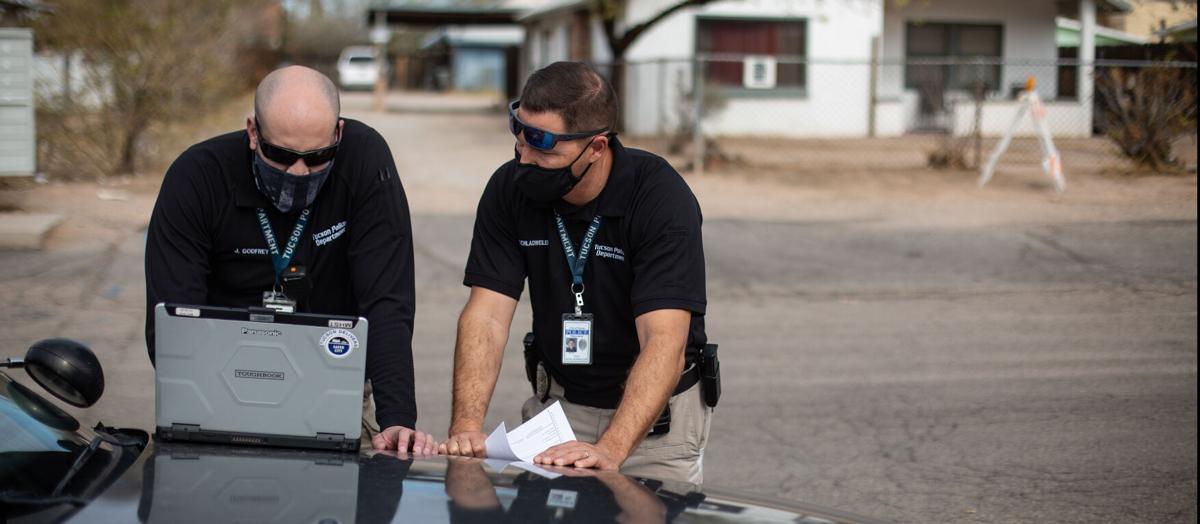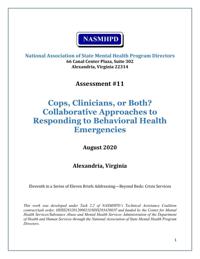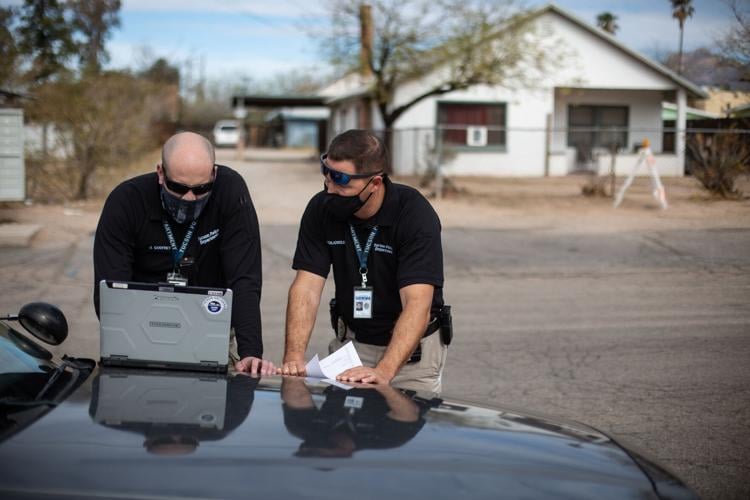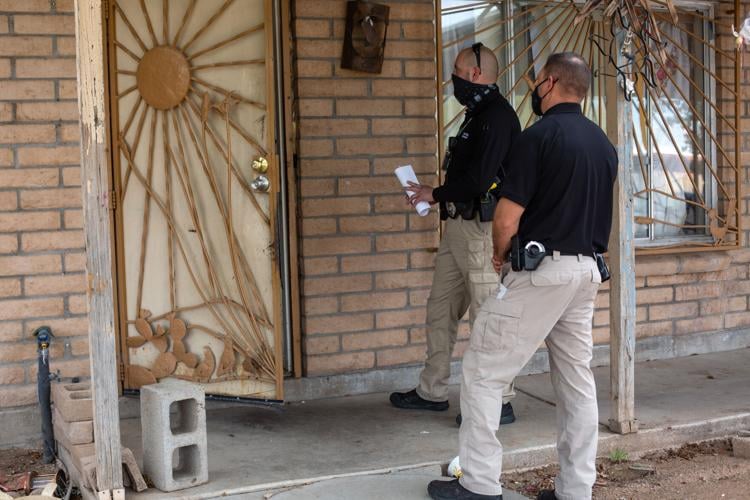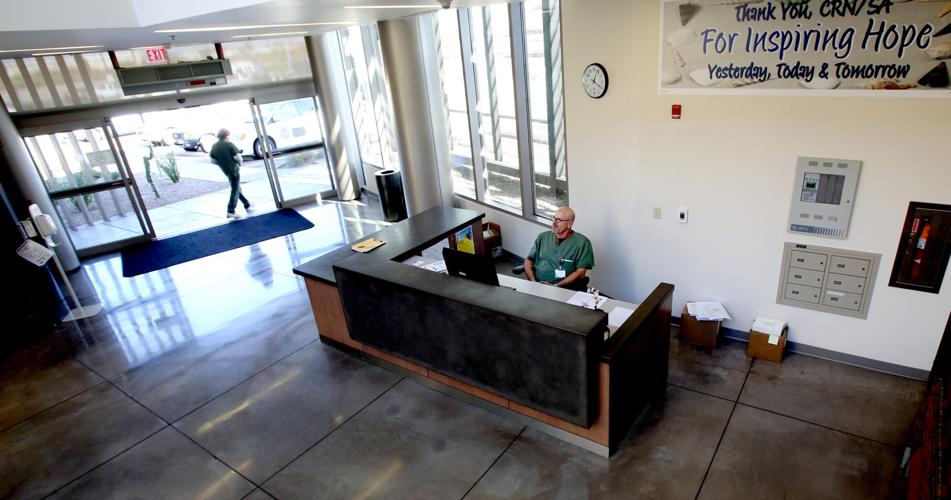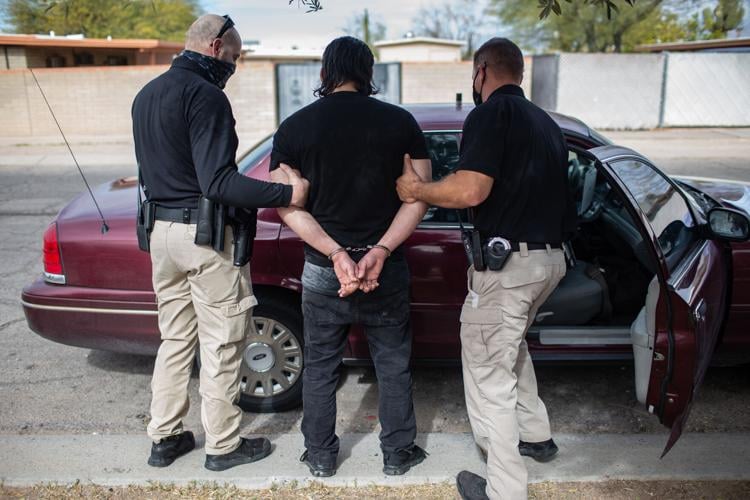Two members of the Tucson Police Department’s Mental Health Support Team knock on the door of a south-side home.
It’s quiet. Then “Black and Yellow” by Wiz Khalifa blasts from the house. Then the volume falls again.
Officers Todd Schladweiler and Josh Godfrey aren’t here to make an arrest, but to connect with a young man who hasn’t been keeping up with his mental health treatment to take him to a behavioral health facility.
“It’s Tucson police. You’re not in trouble, man!” Godfrey hollers over the music.
A young man partially opens the door, looking confused.
“All right, man, sorry to bug ya. CODAC sent us. They said that you haven’t been answering your phone or going to your appointments,” Godfrey tells him.
People are also reading…
The officers identify themselves a few times, but the young man still seems confused — until his confusion turns to fear.
He tries closing the door, but Godfrey pulls it back open and the young man smacks the officer’s hand away. Godfrey handcuffs him — the first time he’s done that in months, he says later — and walks him to the back of Schladweiler’s vehicle on their way to the Crisis Response Center for treatment.
Crisis averted — and that’s the point of the Tucson Police Department’s Mental Health Support Team, which was created in 2014 and has grown to include five officers, two detectives and a sergeant.
The Tucson Police Department's mental health support team aims to protect people who are experiencing a mental health crisis by connecting them to treatment. As part of an Arizona Daily Star special project, here's a look at what this and other police units are doing to help keep community members out of jail.
The team also spurred creation of the department’s Substance Use Resource Team and Homeless Outreach Team. All three reflect TPD’s shifts toward addressing problems in the community by trying to connect people to help rather than arresting people. The Arizona Daily Star has spent time with all three teams in recent months through a reporting fellowship from Solutions Journalism Network.
The team — and the department as a whole — sometimes works with mobile crisis teams from local mental health agencies. The department has also built relationships with crisis observation centers that let officers quickly drop off people experiencing a mental crisis rather than taking them to jail.
While patrol officers respond to active mental health calls, the mental health team works more as a follow-up unit. Members serve mental health court orders and train officers in other units on crisis intervention and mental health first aid.
They have started training other city employees likely to encounter people experiencing a mental health crisis, like those who work for Parks and Recreation and Sun Tran. The goal is to protect people in crisis as well as officers: People with serious mental illness are more likely to be victimized or hurt themselves than to hurt others, studies show.
Jan. 8 shooting leads to focus on mental health
The Pima County Sheriff’s Department, and then TPD, created specialized mental health teams partly in response to the Jan. 8, 2011, shooting outside a Tucson grocery store in which six people died and then-U.S. Rep. Gabrielle Giffords and 12 others were wounded.

Officers Josh Godfrey and Todd Schladweiler of TPD’s Mental Health Support Team talk to a person in the doorway of their home.
The gunman, Jared Lee Loughner, had schizophrenia and had not been forced to take his medication though it was court-ordered. Loughner went through treatment in prison and his mental health was noticeably improved when he was sentenced at the end of 2012. It became evident that the shooting may have been prevented if he had gotten treatment sooner.
The two law enforcement agencies noticed a gap in mental health care without a centralized way to ensure people stayed on their treatment plans. The mental health teams fill that gap by focusing on court orders that begin with an evaluation process called “Title 36,” which determines whether a person who refuses mental health treatment is a danger to themselves or others.
Most of the court orders officers serve are for people not following their mandated treatment plan, Officer Godfrey said.
The teams let officers trained in mental health serve the orders, rather than a patrol officer who may be in a hurry to transport a person to a behavioral health facility between emergency calls, said Jason Winsky, supervisor of the mental health team.
Because they’re not taking 911 calls, mental health team officers have more time to persuade a person to go with them for treatment.
Crisis Response Center ‘was a godsend’
Police transport people most commonly to the Crisis Response Center, on the east end of Banner University Medical Center South. Community Bridges Inc. also offers crisis observation in Tucson.
The Crisis Response Center, operated by Connections Health Solutions, is open 24/7 and has a “no wrong door” policy, meaning it doesn’t turn anyone away no matter how acute their needs.
The center has a separate entrance for law enforcement, speeding up the process and allowing officers to get back out on the field and on to their next court order or call quickly.

The Crisis Response Center at Banner-University Medical Center South has a “no wrong door policy,” meaning it doesn’t turn anyone away no matter how acute their needs.
That’s key to ensuring officers will take someone to the center instead of to jail, says Dr. Margie Balfour, chief of quality and clinical innovation at Connections Health Solutions.
Before the Crisis Response Center opened in 2011, officers sometimes had to wait hours at a hospital to get a person to treatment, TPD Officer Godfrey said. Dropping someone off now takes 10 minutes on average.
“The CRC was a godsend,” he said. “When other cities, other agencies, come to Tucson to see how we do mental health stuff, the first thing we tell them is, ‘You need something like the CRC.’”
The team transports about 500 people annually to a treatment facility, team supervisor Winsky said. The department as a whole transports more than 400 people monthly, on average, to the CRC, according to data from Connections Health Solutions.
The number of police transports to hospitals and crisis observation clinics more than tripled between 2000 and 2019 to almost 7,000 annually, data show.
Culture change prioritizes wellness
Balfour credits the department’s culture change for a drastic decrease in SWAT calls for suicidal barricade situations, which are dangerous to police as well as suspects, and cost about $15,000 each. After 10 suicidal barricade calls in 2012 and 10 in 2013, the number plummeted to two most years, with four in 2015 and three in 2018.
Uniformed officers serving court orders for mental health treatment can frighten patients into locking themselves in their home, leading to a SWAT response. The Mental Health Support Team serves 95% of those orders these days and they do so in plainclothes, which helps de-escalate situations. The officers in all three special teams complete training in negotiation and crisis intervention.

Tucson police Officers Josh Godfrey and Todd Schladweiler of the Mental Health Support Team look over an assignment on a work computer while trying to find a subject in February.
Since the Police Department started working with co-responders from mobile crisis teams, involuntary hospitalization has decreased from 60% of people the mental health team serves with court orders to 20%, Balfour’s data show.
The mental health teams’ two detectives also work with behavioral health centers to identify people who may need help but are not in treatment. And they work with clinicians, trying to get people help before their mental illness leads to court-ordered treatment.
Balfour said TPD has embraced a department-wide culture change that prioritizes the wellness of people who need mental health care over arresting and incarcerating them, making them national leaders in their mental health response approach.
In Arizona, state and federal funding, along with grant money, pays for mobile crisis teams and for behavioral health services that allow places like the CRC to take in anyone who shows up asking for help or anyone police drop off. Arizona Complete Health, the state’s contracted regional behavioral health authority, gets more than $1 billion in federal and state funding for behavioral health services. That money is then distributed to contracted behavioral health providers.
“One of the reasons why what Tucson police is doing works is because they’re not doing it in a vacuum,” Balfour said. “They’re doing it in partnership with a health-care system, meaning the mental health crisis system, that is stepping up to take care of these people.”
She said other people around the country call Connections Health Solutions for advice about improving their crisis response systems. Balfour said those calls have increased since last summer’s anti-police-brutality protests after the killing of George Floyd in Minneapolis.
Team has a backlog of court orders
When Godfrey joined the mental health team, officers got about three or four court orders each day.
“These days it’s probably about five or six,” he said.
The team initially had six officers in three sets to serve orders. Now, it has five officers, which translates to only two sets with double the orders. Those orders accumulate, and with officers having to look for a person more than once most of the time, there’s a backlog of court orders.
“We have just over 100 right now,” Godfrey said. “But a lot of those, probably 80 to 90 of those, are homeless people that we don’t have addresses for.”
Homelessness is often a symptom of substance use or mental health issues, said Kevin Hall, assistant police chief. That’s why the homeless outreach team was created within the Mental Health Support Team.
Balfour says homelessness is a challenge for the behavioral health system as a whole. It’s especially difficult for people experiencing homelessness to follow through with treatment plans and get to appointments.
“How can you even do that if you don’t know where you’re going to lay your head that night?” she said. “Sometimes we forget how hard it is for a patient to do all the things that we’re telling them to do.”
Solving these systemic issues needs to be a priority, not an afterthought, Balfour said. It’s hard for people to be healthy when they don’t have food, affordable housing, a living wage and transportation.
Researcher: Alternatives to police response needed
Alternatives to police response for mental health and substance use point to a shift in public opinion about how these community issues should be addressed, said Jackson Beck of the Vera Institute of Justice in New York, which aims to improve justice systems to better serve communities.
“Police are ill-equipped to safely and effectively serve people experiencing behavioral health crises,” Beck and his colleagues wrote in a Vera Institute report.
“Although many officers may possess de-escalation skills, the mere presence of armed, uniformed officers with police vehicles can exacerbate feelings of distress and escalate mental health-related situations,” the report says.
After George Floyd was killed by a Minneapolis police officer’s knee on his neck last summer, calls to defund police departments increased around the country. The idea is to reallocate funds from police and prisons to services that invest in communities, like education, employment, housing and justice reform.
Community activists also started calling for alternatives to police officers responding to calls regarding mental health, substance use, homelessness and nonviolent crimes.
Several cities including Denver, San Francisco and Portland have made headlines recently for creating nonpolice response teams made up of behavioral health specialists and EMTs. The idea often stems from a program formed in Eugene, Oregon, in 1989 — Crisis Assistance Helping Out on the Streets, or CAHOOTS.
CAHOOTS units include a crisis worker and a medic who are dispatched to some emergency calls and noncriminal crises including homelessness, intoxication, substance use, mental illness and dispute resolution. The program is staffed and managed by White Bird Clinic but funded through Eugene’s Police Department budget.
In Tucson, mobile crisis response teams have been available to respond to mental health crises for more than a decade. Mobile crisis teams respond mostly to mental health calls to the community crisis line, so long as the person in crisis does not have access to weapons and does not have a plan to immediately harm themselves or others, Hall said.
The teams are staffed by behavioral health contractors with the state’s regional behavioral health authority, Arizona Complete Health. In Southern Arizona, those providers are Community Health Associated, Community Bridges Inc., and in Pinal County, Horizon Health and Wellness.

Tucson police Officers Josh Godfrey and Todd Schladweiler of the Mental Health Support Team take a person to the Crisis Response Center after he had stopped going to his court-ordered treatment program. The officers handcuffed the patient after he smacked Godfrey’s hand.
Tucson’s 911 dispatchers have been able to reroute calls to the crisis line since 2015, Arizona Complete Health spokeswoman Monica Coury said in an email. The mobile teams also serve as co-responders at the request of first responders.
Between October 2019 and September 2020, mobile crisis teams in Pima County responded to more than 13,000 calls, Coury said.
In the spring of 2019, four crisis team responders were embedded into the public safety communications center, though they were pulled out during the pandemic. In August, crisis responders got laptops they could use to access the 911 communications system and respond to mental health crises calls while working from home, Hall said. He said he would like to see more crisis response clinicians embedded into the 911 system, eventually with a mental health dispatcher.
Mobile crisis teams responded to about 80% of calls from first responders between Oct. 1, 2019, and Sept. 30, 2020, Coury said.
Since mobile crisis responders moved into the public safety communications center, they saw a 200% increase in monthly call transfers, in which calls are resolved by phone before an emergency responder is dispatched.
The use of mobile crisis teams peaked between October and December of last year, Coury said, with 600 calls transferred from 911 in one quarter.
A January 2020 analysis of co-responder models from Policy Research Inc. and the National League of Cities, shows police departments have adopted several models in recent years. In Springfield, Missouri, officers use iPads to virtually connect with clinicians while out in the field. Colorado Springs, Colorado, created community response teams that include a medical provider, an officer and a clinical behavioral health social worker.
The analysis cites Pima County, highlighting that Tucson and the Pima County Sheriff’s Department’s mental health support teams have had licensed mental health clinicians riding with officers on mental health calls since 2017.
The Tucson Police Department’s Mental Health Support Team stopped having co-responders ride with officers in 2019. Instead, officers can call co-responders to a scene whenever they deem it necessary. The department is working to bring back a co-responder model that works for Tucson, Hall said.
Finding the right option based on a community and its needs is a good goal, said Beck, of the Vera Institute. But the best path to achieving a goal that best serves everyone is to pull police from the equation altogether.
“Across the country there’s no ‘one-size-fits-all.’” Beck said. “Communities need to make these decisions together while centering the voices of those with lived experience.”
Tucson's Substance Use Resource Team educates people about community resources and provides rides to detox facilities for people ready to take…


